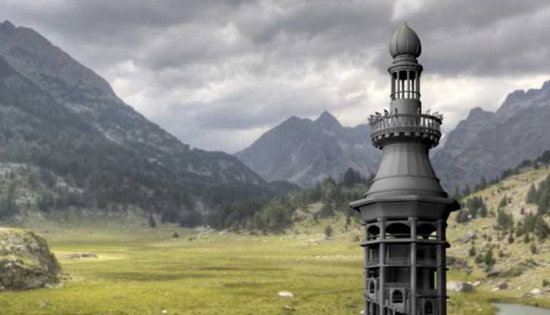In Retrospect by Ellen Larson
What would you do if you had to investigate a murder
you would gladly have committed yourself?

Approach to the Priory
Back to the creation of artwork for the priory.
The walkway led through a maze of flower beds, well-tended and blooming with daffodils and iris. Violets grew in the cracks between the flagstones. The Oku had always been ferocious landscapers, performing agronomic wizardry on the rocky soils and mountainous terrains that dominated their city state. The Priory gardens had been a showcase, attracting a steady stream of visitors each summer, before the war.
As they neared the front entrance, Merit’s gaze was caught by a tall, thin man standing between the fluted columns at the back of the portico. He was dressed in black and wore an Okuchan half-shield—not the featureless Rasakan vizard, meant to conceal and affront, but a triad of interlaced triangles carved with numerous eyes; a work of high craft understood to represent unwavering allegiance to a noble master.
...
The Steward bowed again, then led the way past a pair of russet-clad JCP sentries and through the green door at the back of the portico.
A bird’s eye view of the Priory would have shown four massive red-granite wings enclosing a square courtyard, with the four towers rising at the corners. In their day, the eighty-odd rooms of the Priory had served not merely as the residence of the Prioress, whose job it was to manage the non-academic side of the Conservatory, but as a gathering place for the elite among the Oku scientific community. The Great Hall had seen an endless stream of teas, awards days, and seminars, as well as art shows, inductions, poetry readings, and musical events of the highest quality. Under the Rasakan Protectorate—and given the obliteration of the Conservatory—there was no longer any such need, thus most of the rooms were kept locked. But each had a story to tell, each was a testament to five hundred years of Okuchan civilization.In a silence broken only by the echo of their footfalls on the stone floor, the Site Team followed the Steward down a high-ceilinged hall. Red sunlight filtered through high-set windows, patterning the floor and illuminating the portraits of Prioresses gone by on the opposite wall. At the far end was a cedar door, decorated with a painted carving of a pomegranate tree. Another, lesser hall and a wooden staircase led them to the first floor of the east wing. They heard the murmur of voices and caught a whiff of baking bread. But the Steward turned away from these homely signs of occupation and led them through a sitting room and up another flight of stairs into the southeast tower.
At the top of that stair they entered an octagonal landing with open arches in each wall. They looked over the green tile rooftop to the courtyard below, with its empty benches and silent fountain.
Back to the creation of artwork for the priory.
